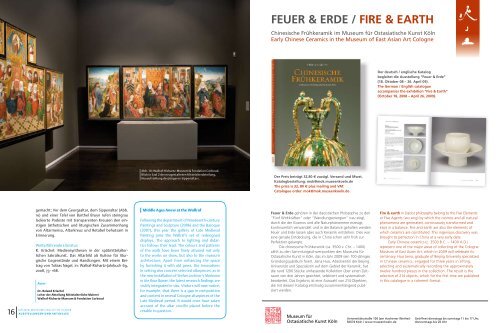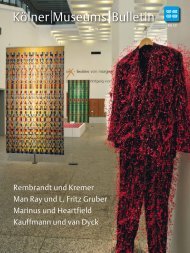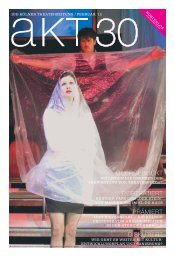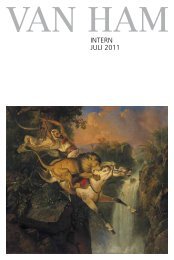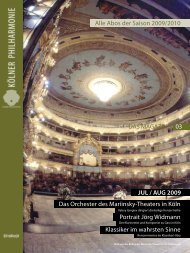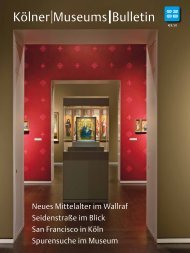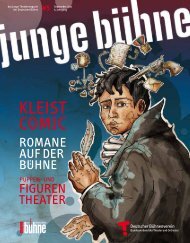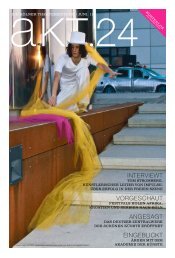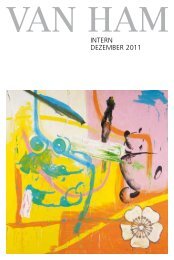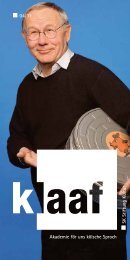FEUER & ERDE / FIRE & EARTH
FEUER & ERDE / FIRE & EARTH
FEUER & ERDE / FIRE & EARTH
Sie wollen auch ein ePaper? Erhöhen Sie die Reichweite Ihrer Titel.
YUMPU macht aus Druck-PDFs automatisch weboptimierte ePaper, die Google liebt.
gemacht: Vor dem Georgsaltar, dem Sippenaltar (Abb.<br />
10) und einer Tafel von Barthel Bruyn rufen steingrau<br />
lackierte Podeste mit transparenten Kreuzen den einstigen<br />
ästhetischen und liturgischen Zusammenhang<br />
von Altarmensa, Altarkreuz und Retabel behutsam in<br />
Erinnerung.<br />
Weiterführende Literatur:<br />
R. Krischel: Mediensynthesen in der spätmittelalterlichen<br />
Sakralkunst. Das Altarbild als Kulisse für liturgische<br />
Gegenstände und Handlungen. Mit einem Beitrag<br />
von Tobias Nagel, in: Wallraf-Richartz-Jahrbuch 69,<br />
2008, 73 - 168.<br />
Autor:<br />
Dr. Roland Krischel<br />
Leiter der Abteilung Mittelalterliche Malerei<br />
Wallraf-Richartz-Museum & Fondation Corboud<br />
Kölner MuseuMs- Bulletin 3|2008<br />
16 aUSStellUnGen Und aKtUelleS<br />
Abb. 10: Wallraf-Richartz-Museum & Fondation Corboud,<br />
Blick in Saal 2 der neugestalteten Mittelalterabteilung,<br />
Neuaufstellung des Jüngeren Sippenaltars.<br />
Middle ages anew at the Wallraf<br />
Following the department of nineteenth-century<br />
Paintings and sculpture (2006) and the Baroque<br />
(2007), this year the gallery of late Medieval<br />
Painting joins the Wallraf’s set of redesigned<br />
displays. the approach to lighting and didactics<br />
follows their lead. the colours and patterns<br />
of the walls have been finely attuned not only<br />
to the works on show, but also to the museum<br />
architecture. Apart from enhancing the space<br />
by furnishing it with old pews, the innovations<br />
in setting also concern selected altarpieces: as in<br />
the new installation of stefan lochner’s Madonna<br />
in the Rose Bower, the latest research findings are<br />
visibly integrated in situ. Visitors will now notice,<br />
for example, that there is a gap in composition<br />
and content in several Cologne altarpieces of the<br />
late Medieval period. it would once have taken<br />
account of the altar crucifix placed before the<br />
retable in question.<br />
<strong>FEUER</strong> & <strong>ERDE</strong> / <strong>FIRE</strong> & <strong>EARTH</strong><br />
Chinesische Frühkeramik im Museum für Ostasiatische Kunst Köln<br />
Early Chinese Ceramics in the Museum of East Asian Art Cologne<br />
Der Preis beträgt 32,80 � zuzügl. Versand und Mwst.<br />
Katalogbestellung: mok@mok.museenkoeln.de<br />
The price is 32, 80 � plus mailing and VAT.<br />
Catalogue order: mok@mok.museenkoeln.de<br />
Feuer & Erde gehören in der daoistischen Philosophie zu den<br />
“Fünf Wirkkräften” oder “Wandlungsenergien” (wu xing),<br />
durch die der Kosmos und alle Naturphänomene erzeugt,<br />
kontinuierlich verwandelt und in der Balance gehalten werden.<br />
Feuer und Erde lassen aber auch Keramik entstehen. Dies war<br />
eine geniale Ent deckung, die in China schon sehr früh zur<br />
Perfektion gelangte.<br />
Die chinesische Frühkeramik (ca. 3500 v. Chr. – 1400)<br />
zählt zu den Sammlungsschwerpunkten des Museums für<br />
Ostasiatische Kunst in Köln, das im Jahr 2009 sein 100-jähriges<br />
Gründungs jubiläum feiert. Jiena Huo, Absolventin der Beijing<br />
Universität und Spezialistin auf dem Gebiet der Keramik, hat<br />
die rund 1200 Stücke umfassende Kollektion über einen Zeit-<br />
raum von drei Jahren ge sichtet, selektiert und systematisch<br />
bearbeitet. Das Ergebnis ist eine Auswahl von 214 Objekten,<br />
die mit diesem Katalog erstmalig zusammenhängend publiziert<br />
werden.<br />
Museum für<br />
Ostasiatische Kunst Köln<br />
Der deutsch / englische Katalog<br />
begleitet die Ausstellung “Feuer & Erde”<br />
(18. Oktober 08 – 26. April 09).<br />
The German / English catalogue<br />
accompanies the exhibition “Fire & Earth”<br />
(October 18, 2008 – April 26, 2009).<br />
Universitätsstraße 100 (am Aachener Weiher)<br />
50674 Köln / www.museenkoeln.de<br />
Fire & earth in Daoist philosophy belong to the Five Elements<br />
or Five Agents (wu xing) by which the cosmos and all natural<br />
phenomena are generated, continuously transformed and<br />
kept in a balance. Fire and earth are also the elements of<br />
which ceramics are constituted. This ingenious discovery was<br />
brought to perfection in China at a very early date.<br />
Early Chinese ceramics (c. 3500 B.C. – 1400 A.D.)<br />
represent one of the major areas of collecting of the Cologne<br />
Museum of East Asian Art, which in 2009 will celebrate its<br />
centenary. Huo Jiena, graduate of Beijing University specialized<br />
in Chinese ceramics, engaged for three years in sifting,<br />
selecting and systematically recording the approximately<br />
twelve hundred pieces in the collection. The result is the<br />
selection of 214 objects, which for the first time are published<br />
in this catalogue in a coherent format.<br />
Geöffnet dienstags bis sonntags 11 bis 17 Uhr,<br />
donnerstags bis 20 Uhr


